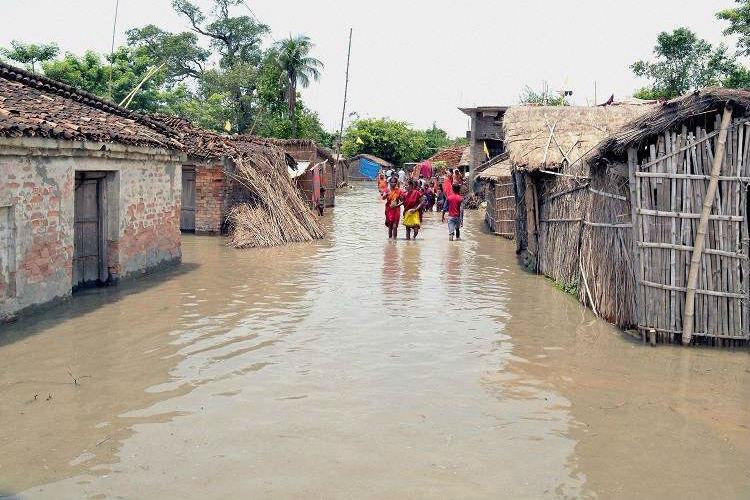Bihar: Flood-Like Situation in October Result of Climate Change-Induced Changing Pattern of Rainfall

Image Courtesy: PTI
Patna: It is unexpected that in the second week of October in Bihar, there is a flood-like situation in dozens of villages in east Champaran, west Champaran, Gopalganj and Muzaffarpur districts in the state due to which hundreds of people were displaced and forced to take shelter in nearby high rise roads and embankments. Gandak river is flowing above the danger mark at a few places on Monday following the release of record water from Valmiki Gandak barrage into river Gandak two days ago after heavy rainfall was reported in the catchment area in neighbouring Nepal and medium to heavy rains in the state as well.
The India Meteorological Department (IMD) has also forecasted heavy rainfall in five districts and moderate to light rains in over a dozen out of the 38 districts of the state in Koshi, Gandak basin and Seemanchal region on Monday as the monsoon is yet to return, causing a worry for people especially farmers across the state. The return of Monsoon in the state was delayed this year. ”In October so far Bihar received more than normal rainfall like last year,” an official of IMD here told NewsClick.
According to IMD officials, Bihar recorded 44.6 mm of rainfall from 1 to 6 October against the normal rainfall of 23.4 mm. This is 91% more than the normal rainfall during the period.
Usually, by the first week of October, people have no fear of floods and heavy rains. But in recent years it is changing. This has come as a big surprise for Prahlad Yadav, Vijay Singh and Daroga Das, all residents of Bin village under Sangrampur in East Champaran after their village was marooned by Burhi Gandak floods on Saturday after authorities of Bihar Water Resources department released 4.45 lakh cusecs water into river Gandak on Friday.
“It is the first time in the last one and a half decade that we have been facing a flood in our village in October with rains continuing for the last few days and the local met office forecasted more rains in the next two to three days. We were not ready for this,” Yadav told NewsClick.
Another villager Vijay Singh said fear of flood is new in October because floods usually pose a threat from July to September.
Similarly, Ajay Singh, Lakhinder Shah, and Vinod Sahnj, residents of a village under Sariya block in Muzaffarpur are facing a flood-like situation after the water level rose in river Gandak. “Hundreds of farmers, mostly small and marginal, are a worried lot. They are feeling helpless after rising water levels in Gandak flooded and badly damaged standing paddy crops and vegetables on nearly 300 acres, their source of livelihood. They have no hope of getting any input subsidy for their losses from the government,” Shah told NewsClick.
Standing crops were also damaged on more than 400 acres in the riverine belt in Sahebganj in the district after the release of water from the barrage into river Gandak. “Hundreds of people from over half a dozen villages have take shelter on the nearby embankment for safety following flood water entered on Sunday,” Jitendra Rai, a villager told NewsClick.
Last year, heavy rainfall in October damaged standing crops in the state. Climate change-induced changing patterns of rainfall in Bihar are a new challenge for farmers. In recent years, poor monsoon, long dry spell and erratic rainfall followed by untimely heavy rainfall badly affect farmers and destroyed their Kharif crops and sowing for Rabi crops were delayed as farmlands are either waterlogged or have deep moisture.
Hundreds of thousands of farmers have faced the adverse impact of changing rainfall patterns in Bihar in recent years. The changing patterns are due to global warming according to a report by the Intergovernmental Panel on Climate Change.
Abdus Sattar, senior scientist at the Centre for Advanced Studies on Climate Change, Rajendra Prasad Central Agricultural University, Pusa, Samastipur district, told NewsClick that heavy rainfall and floods in October are examples of the direct result of changing patterns of rainfall due to climate change.
“The impact of changing climate is now clearly visible on rainfall patterns and crop production as well. This year although the monsoon came on the right note and time, it has behaved erratically throughout Bihar since its arrival. July remained almost dry followed by a good rainfall in the state. But, distribution remained highly erratic. One thing is very clear, pre-monsoon and Sept-Oct rainfall are increasing. This has been happening for the last two to three years. Last year, October experienced extreme flooding and it caused severe water logging in agricultural fields, due to which wheat sowing was delayed and as a result wheat faced terminal heat stress and wheat yield was reduced,” said Sattar.
Taking the changing pattern of rainfall seriously, Chief Minister Nitish Kumar stressed the need to change the crop cycles to increase farm income. The government has launched an alternative cropping scheme to provide an alternative to farmers in view of changing patterns of rainfall.
Till mid-August this year, paddy farmers in the state were worried as the state has recorded deficit rainfall since June this year. Paddy fields were dry and had developed huge cracks, an alarming situation for rainfed rice growers. The transplantation of paddy seedlings was delayed due to rainfall deficits in June and July.
Bihar farmers usually go for paddy sowing after June 20. But poor monsoons and the long dry spell had triggered fear of drought in August this year after a gap of two years.
Monsoon normally hits the state between June 12 and 14. An estimated two-thirds of Bihar’s 12 crore population and nearly two-thirds of all agricultural activity are dependent on yearly monsoons.
Get the latest reports & analysis with people's perspective on Protests, movements & deep analytical videos, discussions of the current affairs in your Telegram app. Subscribe to NewsClick's Telegram channel & get Real-Time updates on stories, as they get published on our website.
























